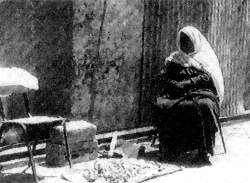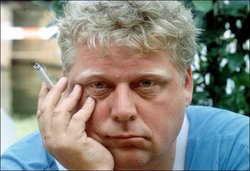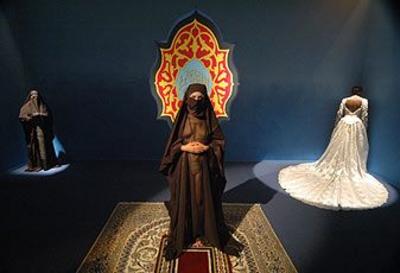| December
2 , Thursday, 7:30PM
Art &
Politics
In this program we will begin to
explore the complex relationship between politics
and art in film. Looking at several short works
that express their political ideologies through
very different approaches from lyrical meditations
on the daily crisis in Palestine to an in your
face testimony of a suicide bomber, we will undoubtedly
raise more questions than answers at the end of
the night.
Tension 26 min, video, 1998
Director:Rashid Masharawi (Palestine)
Palestinian
director Rashid Masharawi conveys
the palpable sense of tension that he perceived
below the surface of daily life for the Palestinian
population during the period of the "peace
process." Tension focuses
on the act of observation itself, eschewing
spoken dialogue altogether for a narrative that
is produced rather through the editing of images,
music, and incidental sounds on the track. Tension
is organized around the natural cycle of sunrise
and sunset, restated in terms of another "natural"
work cycle: the many waves of Palestinian day
workers who move through gates and checkpoints
to labor in Israel and return each evening.

Born in 1962 in the Al-Shati refugee camp in
Gaza, Masharawi is the director
of several documentaries and fiction films.
He is also the winner of many international
awards, including the UNESCO Award at the 1996
Cannes Film Festival. In 1996, Masharawi
founded the Cinema Production Centre in Ramallah,
West Bank, which aims to improve and develop
the Palestinian movie industry by encouraging
and training young Palestinian movie-makers.
Aninnovative artist, Masharawi created the Mobile
Cinema which has allowed thousands of children
to enjoy local and foreign films.
Submission
10min,
video, 2004
Director: Theo Van Gogh (Holland)


Controversial Dutch filmmaker and newspaper
columnist Theo van Gogh, who made a film about
violence against women in Islamic societies,
was stabbed and shot dead in Amsterdam on November
2. Van Gogh was criticized for a film, Tension,
shown this year on Dutch television about a
Muslim woman forced into an arranged marriage
who is abused by her husband and raped by her
uncle. One of his colleagues said he was a champion
of free speech. Van Gogh was stabbed and shot
near a park in central Amsterdam. “He
did receive death threats but he never took
them quite seriously. He was a controversial
figure and a champion of free speech,”
a colleague at Van Gogh’s film production
company said. Van Gogh had also been working
on a feature film about the 2002 murder of controversial
anti-immigration populist Pim Fortuyn, which
was due to make its premier in January with
previews to be shown on the Internet next month.
Van Gogh received death threats after Submission
was broadcast on Dutch national television earlier
this year. He made the film with Dutch politician
Ayaan Hirsi Ali, a Somali refugee given Dutch
citizenship after fleeing an arranged marriage
12 years ago. Hirsi Ali, who calls herself an
ex-Muslim, has been under police protection
since receiving death threats because of the
film.
Meeting
Evil 9min,
Video, 2002
Director: Reza Parsa
A
man is sitting on the back seat of a car. He
has twelve minutes left to live and speaks his
words of valediction into the camera. A disturbing
and highly controversial film which has been
screened at Cannes. “Perhaps the
most astonishing moments ever created in a Swedish
film”, according to Ingmar Bergman.
Director
Reza Parsa, born in 1968,
comes from Tehran and has been living in Sweden
since 1980. At the age of 22 he enrolled at
the Danish Film School where he trained as
a director. He has made ten short films so
far. His feature film debut “Before
the Storm” has won national and international
awards. Filmography (Selection): 1995: Never;
1997: Tigerheart; 1998: The 8th Song; 2000:
Before the Storm; 2002: Meeting Evil
Journeys
40min,
35min on video, 2003
Director: Vinayan Kodoth (India)
"In
the Indian city of Mumbai (Bombay), the long
trips commuting from home to work and back again
is gradually taking on unbearable proportions.
The trains are so overcrowded that people can
only board, using their elbows. At first, the
scenes of people frenetically trying to secure
a seat are almost funny: it seems like a game
of musical chairs. At the same time, it’s
clear that the lack of capacity is leading to
perilous situations. People ride with their
bodies sticking outside the train, they sit
on the roof and hang off the sides. They often
jump on while it is still moving. The rush and
stress causes people to be very careless and
agressive. A newspaper headline ‘14 dead
in 24 hours’ speaks volumes. From a distance,
the throng of people is the streets is a column
of ants. A general view shows how choked up
the arterial roadways really are. There is contrast
between the slum-swellers scratching out a living
in the small spaces between the roads and the
tracks and a glittering Bombay city soaring
above them. Roads are lined with billboards
advertising luxury items. Thus, the film raises
questions about progress and urbanisation and
the price that is paid." - International
Documentary Film Festival (Amsterdam)
Vinayan
Kodoth was born in 1963, in Kerala,
India. He completed a post-graduate degree
in literature in 1986. In 1989 he joined the
film direction program at the Film and Television
Institue of India in Pune. Between 1992 and
1996, he worked in television in Mumbai (Bombay).
Since 1996, he has taught film and video at
the National Institute of Design, Ahmedabad.
|
